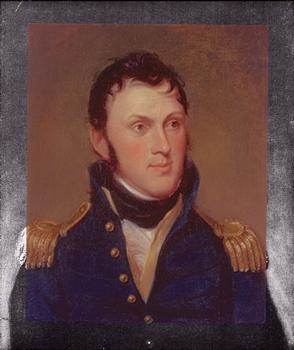Biographical Information
| Name: | Stephen Long |
|---|---|
| Full name: | Stephen Harriman Long |
| Born on | 30 December 1784 in Hopkinton, Merrimack County, New Hampshire, USA, North America |
| Deceased on | 4 September 1864 in Alton, Madison County, Illinois, USA, North America |
Short biography of Stephen Harriman Long
Stephen Harriman Long was one of the 10 children born to Moses and Lucy Harriman Long. At the age of 21 he began studying at Dartmouth College, from where he graduated in 1809. He then worked for several years as a teacher in New Hampshire and Pennsylvania. Influenced by General Joseph Swift, chief of the Engineering Corps of the US Army at that time, Long joined the army in 1815 as a second lieutenant, taught mathematics at West Point Military Academy for one year (see section 2.3.6) and was promoted to the rank of major. During the following decade, Long undertook five great expeditions in western USA, including one in the Rocky Mountains and another in the Yellowstone region. He produced maps of these areas which would later prove very important for the building of railways. After Congress passed a law in 1824 permitting military engineers to work on the building of civilian infrastructure, especially railways, Long was put in charge of building the Baltimore & Ohio Railroad in 1827. Long had already had papers on railway engineering published in journals and was well known in this field. He had turned to bridge-building by 1829, and in 1830 designed the Jackson Bridge near Baltimore, a timber trussed framework bridge (see Fig. 2-32/top), for which he was granted a patent in that same year and which was presented in a paper [Long, 1830/1]. He returned to the Jackson Bridge in a second paper and investigated the loadbearing behaviour of his trussed framework system [Long, 1830/2]. “Long was the first person to understand the engineering principles of preload and to apply them to a bridge truss” [Griggs & DeLuzio, 1995, p. 1353]. It was in 1836 that Long provided tables of his trussed framework system for 20 spans between 55 and 300 feet with which the depth of truss and cross-sectional areas of members could be determined [Long, 1836; Gasparini & Provost, 1989, p. 30]. In the two patents of 1839, Long develops the trussed framework concept even further (see, for example, [Long, 1839/1]). No less a person than Karl Culmann revealed his admiration for Long's trussed framework bridges in his travelogue [Culmann, 1851; 1852], on which Timoshenko comments as follows:"Long's system of trusses was similar to that of Palladio, but he evidently knew a valid method of calculating stresses in truss members and, in his work [see [Long, 1839/1] – the author], gave very reasonable proportions for all the members of structures of various spans. After describing some of Long's bridges, Culmann remarks that he was unable to find out if Long was still alive and, if so, what he was doing” [Timoshenko, 1953/1, p. 191]. From 1838 onwards, Long worked in the newly formed US Corps of Topographical Engineers, and by 1861 had become chief topographical engineer to the federal government.
Main contributions to structural analysis:
Observations on wooden, or frame bridges [1830/1]; Description of the Jackson Bridge together with directions to builders of wooden framed bridges [1830/2]; Description of Col. Long's bridges together with a series of directions to bridge builders [1836]; Improved brace bridge [1839/1]; Specifications of a brace bridge and of a suspension bridge [1839/2]
Source: Kurrer, Karl-Eugen The History of the Theory of Structures, Wilhelm Ernst & Sohn Verlag für Architektur und technische Wissenschaften GmbH, Berlin (Deutschland), ISBN 3-433-01838-3, 2008; p. 745
Relevant Publications
- (2008): The History of the Theory of Structures. From Arch Analysis to Computational Mechanics. 1st edition, Wilhelm Ernst & Sohn Verlag für Architektur und technische Wissenschaften GmbH, Berlin (Germany), ISBN 978-3-433-01838-5, pp. 848.
- (2018): The History of the Theory of Structures. Searching for Equilibrium. 2nd edition, Wilhelm Ernst & Sohn Verlag für technische Wissenschaften, Berlin (Germany), ISBN 978-3-433-03229-9, pp. 1024-1025.
- (1995): Stephen H. Long and Squire Whipple: The First American Structural Engineers. In: Journal of Structural Engineering (ASCE), v. 121, n. 9 (September 1995), pp. 1352-1361.
- (2003): Stephen Harriman Long and William Wallace Moore. In: Leadership and Management in Engineering (ASCE), v. 3, n. 3 (July 2003), pp. 161-164.
- About this
data sheet - Person-ID
1009845 - Published on:
20/08/2013 - Last updated on:
22/07/2014




